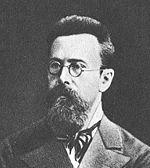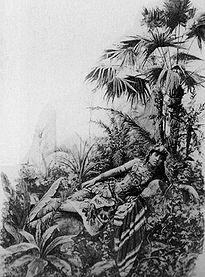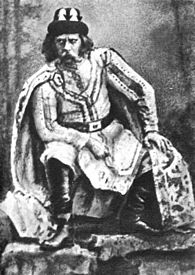- Mlada (Rimsky-Korsakov)
-
Operas by Nikolai Rimsky-Korsakov 
The Maid of Pskov (1872)
May Night (1879)
The Snow Maiden (1881)
Mlada (1890)
Christmas Eve (1895)
Sadko (1896)
Mozart and Salieri (1897)
The Noblewoman Vera Sheloga (1898)
The Tsar's Bride (1898)
The Tale of Tsar Saltan (1900)
Servilia (1901)
Kashchey the Deathless (1902)
Pan Voyevoda (1903)
The Invisible City of Kitezh (1905)
The Golden Cockerel (1907)Mlada (Russian: Млада, the name of a main character) is an opera-ballet in four acts, composed between 1889 and 1890 by Nikolai Rimsky-Korsakov, to a libretto by Viktor Krylov that was originally employed for an aborted project of the same name from 1872.
Contents
Performance history
The St. Petersburg premiere of Rimsky-Korsakov's setting of the libretto was given on 1 November 1892 and conducted by Eduard Nápravník. The scene designers were Ivan Andreyev and Mikhail Bocharov; balletmasters were Lev Ivanov and Enrico Cecchetti. The first production of Mlada was not a success, and it did not become a regular repertory item. (The decor, however, was reused for Petipa's 1896 revival of the ballet adaptation of the scenario by composer Ludwig Minkus, which had premiered in 1879.)
Other notable performances of Rimsky-Korsakov's Mlada were given in 1904 in St. Petersburg in the Great Hall of the St. Petersburg Conservatory by Tsereteli's opera company; in 1913 in Moscow by the Zimin Opera; and in 1923 in Petrograd at the State Theatre of Opera and Ballet.
A more recent production of the opera-ballet at the Bolshoi Theatre was recorded on video.[1]
Roles
Role Voice type Premiere cast
11 November 1892
(Conductor: Eduard Nápravník)Mstivoy, prince of Retra bass Fyodor Stravinsky Voyslava, his daughter soprano Olga Olgina, Evelina Sonki Yaromir, prince of Arkona tenor Mikhail Mikhaylov Shade of Princess Mlada silent role Marie Petipa Lumir, Czech singer alto Mariya Dolina Morena, goddess of the underworld, appearing in the first act in the form of the old woman Svyatokhna mezzo-soprano Maria-Vilgelmina Piltz Moor from the Caliphate tenor Vasily Karelin The Novgorodian tenor Grigory Ugrinovich Wife of the Novgorodian mezzo-soprano Elena Markovskaya A Varangian baritone Maksim Titov Tiun bass Aleksandr Klimov High Priest of Radegast baritone Chornobog chorus Kashchey the Immortal chorus Chuma (Plague), god of pestilence silent role Cherv (Worm), god of the destruction of grasses (famine) silent role Topelets, god of floods and sinkings silent role Shade of Queen Cleopatra silent role Chorus, silent roles: Maidens, armor-bearers and retinue of Mstivoy, merchants, supplicators, people of various Slavic lands, priests and priestesses of Radegast, trumpeters, wood-sprites, werewolves, kikimoras, witches, ghosts of the deceased, ghosts of dancers, of black male and female slaves of Queen Cleopatra, spectres of bogatïrs, Slavic gods Synopsis
- Time: The ninth or tenth century
- Place: The Slavic lands of the Baltic sea-coast, in the city of Retra, near the Laba (Elbe) River.[1]
Act 1
Voyslava has killed Mlada, Yaromir's bride, to have him for herself. With the help of Morena, the goddess of the underworld, she has captivated Yaromir. But he sees the murder in his dreams.
Act 2
At the midsummer festival the people dance, while the spirit of Mlada interves between Yaromir and Voyslava.
Act 3
By night Mlada leads Yaromir up Mount Triglav, where the dead gather, before the Witches' Sabbath in which Yaromir is shown a vision of Cleopatra.
Act 4
Yaromir, at the Temple of Radegast, is shown by the spirits that Voyslava is guilty. She confesses her sin and he kills her. Morena, with whom Voyslava had made a compact, destroys the temple and the city of Retra, but Yaromir is united with Mlada in heaven.
Concert excerpts
Two orchestral works were derived from the opera by the composer. The first, Night on Mt. Triglav, is an arrangement of Act 3. The second is a suite.
- Night on Mt. Triglav (1899–1901)
This is a purely orchestral arrangement of Act III, restyled as a lengthy symphonic poem for orchestra. Approximately a half hour in duration, the program in the printed score follows the action of the opera during the corresponding act of the opera.
- Suite from the Opera-Ballet Mlada (1903)
- Introduction
- Redowa: A Bohemian Dance
- Lithuanian Dance
- Indian Dance
- Cortège
The Redowa appears in Act 1. The Lithuanian Dance and the Indian Dance are taken from Act 2, Scene 5. The cortège is the well-known Procession of the Nobles (Russian: Шествие князей, literally, Procession of the Princes), and appears in Act 2, Scene 3.
Trivia
"Procession of the Nobles" was long used as the theme for the PBS public affairs program Washington Week in Review.
Recordings
Audio Recordings (Mainly studio recordings)
Source: www.operadis-opera-discography.org.uk
- 1962, Evgeny Svetlanov (conductor), Moscow Radio Symphony Orchestra and Chorus, Vladimir Makhov (Yaromir), Tatyana Tugarinova (Voyslava), Alexey Korolyov (Mstivoy), Nina Kulagina (Morena)
References
- Notes
- ^ List of characters and Setting from Rimsky-Korsakov, Nicolai; Dr. Olga Browning (Foreword translated by) (1983) (in Russian). Mlada: An Opera Ballet in Four Acts; Vocal Score. The Complete Works of Nicolai Rimsky-Korsakov. Melville, N.Y.: Belwin Mills Publishing Corp. K5255.
- Sources
- Abraham, Gerald. "Rimsky-Korsakov's Mlada," in On Russian Music. London: W. Reeves, 1939; rpt. New York: Books for Libraries, 1980.
- Gaub, Albrecht. Die kollektive Ballett-Oper "Mlada": ein Werk von Kjui, Musorgskij, Rimskij-Korsakov, Borodin und Minkus. Studia slavica musicologica; Bd. 12. Berlin: Kuhn, 1998. ISBN 3-928864-53-X
- Rimsky-Korsakov, N.A.. My Musical Life. Ed. with an introduction by Carl van Vechten; trans. by Judah A. Joffe. 3rd American ed. A. A. Knopf, 1942.
- Rimsky-Korsakov, Nicolai; Dr. Olga Browning (Foreword translated by) (1983) (in Russian). Mlada: An Opera Ballet in Four Acts; Vocal Score. The Complete Works of Nicolai Rimsky-Korsakov. Melville, N.Y.: Belwin Mills Publishing Corp. K5255.
External links
- Score of the opera at IMSLP.
- Bilingual libretto in PDF format (Russian, Latin transliteration and English)
- Russian libretto in zip file for Word
Categories:- Operas by Nikolai Rimsky-Korsakov
- Russian-language operas
- Operas
- 1890 operas
- Opéras-ballets
- 1892 ballet premieres
Wikimedia Foundation. 2010.



